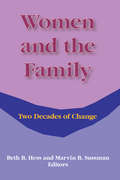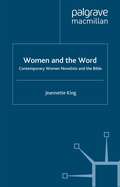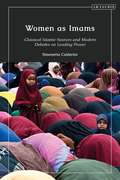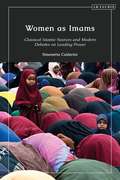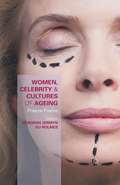- Table View
- List View
Women and Science: An Annotated Bibliography
by Marilyn B. Ogilvie Kerry L. MeekFirst Published in 1996. Routledge is an imprint of Taylor & Francis, an informa company.
Women and Science: An Annotated Bibliography
by Marilyn B. Ogilvie Kerry L. MeekFirst Published in 1996. Following the author's previous work, Women in Science: Antiquity through the Nineteenth Century in 1986, an increased interest in feminism, science, and gender issues resulted in this subsequent title. This book will be valuable to scholars working in a variety of academic areas and will be useful at different educational levels from secondary through graduate school. This annotated bibliography of approximately 2700 entries also includes fields, nationality, periods, persons/institutions, reference, and theme indexes.
Women and Shari'a Law: The Impact of Legal Pluralism in the UK
by Elham ManeaShould shari'a law be introduced into the British legal system? Elham Manea explores this question as a human rights activist and Arab scholar who identifies herself as Muslim. In response to recent media controversy and public debate about legal pluralism and multiculturalism, Manea argues against what she identifies as the growing tendency for people to be treated as 'homogenous groups' in Western academic discourse, rather than as individuals with authentic voices. Building on her knowledge of the situation for women in Middle Eastern and Islamic countries, she undertakes first-hand analysis of the Islamic shari'a councils and Muslim arbitration tribunals in various British cities.
Women and Spirituality in the Writing of More, Wollstonecraft, Stanton, and Eddy
by A. InghamThis comparative study graphs the feminist theological trajectory of the religious writings of four eclectic, but similar, women: Hannah More, Mary Wollstonecraft, Elizabeth Cady Stanton, and Mary Baker Eddy.
Women and the Anglican Church Congress 1861-1938: Space, Place and Agency (Bloomsbury Studies in Religion, Gender, and Sexuality)
by Sue Anderson-Faithful Catherine HollowayThis book covers new ground in its focus on the Anglican Church congresses 1861-1938 as a public space in which the views of notable women were widely disseminated. It celebrates the contribution made by women to public life and discourse on womanhood as platform speakers, and commemorates the presence of the large numbers of women who joined congresses as audience members. Original research draws on extensive primary sources from official records, diaries and the press to capture women's views and voices and to evoke congress as a communicative social space and a window into topical affairs. Women and the Anglican Church Congress 1861-1938 examines the roles of women in the Church and reflects on how women with a sense of vocation negotiated contemporary attitudes to their positions and spirituality. The book also explores how women's secular aspirations towards citizenship in the context of poverty, work, temperance, eugenics, class and suffrage played out at congress.
Women and the Anglican Church Congress 1861-1938: Space, Place and Agency (Bloomsbury Studies in Religion, Gender, and Sexuality)
by Sue Anderson-Faithful Catherine HollowayThis book covers new ground in its focus on the Anglican Church congresses 1861-1938 as a public space in which the views of notable women were widely disseminated. It celebrates the contribution made by women to public life and discourse on womanhood as platform speakers, and commemorates the presence of the large numbers of women who joined congresses as audience members. Original research draws on extensive primary sources from official records, diaries and the press to capture women's views and voices and to evoke congress as a communicative social space and a window into topical affairs. Women and the Anglican Church Congress 1861-1938 examines the roles of women in the Church and reflects on how women with a sense of vocation negotiated contemporary attitudes to their positions and spirituality. The book also explores how women's secular aspirations towards citizenship in the context of poverty, work, temperance, eugenics, class and suffrage played out at congress.
Women and the Authority of Scripture: A Narrative Approach
by Sarah Heaner LancasterThe theological impact of accepting the absolute authority of biblical scripture is enormous-especially for women who attend and serve churches. But until now, few books have been willing to address this issue head on.Sarah Lancaster looks at the way women in the church have dealt with the question of scriptural authority and how they can address it in the future. Some women, she says, accept the authority of the Bible without question and stay in church without change of attitude or action. Others deny that the Bible has any authority, completely leaving Christianity in the belief that the Bible and Christian tradition are irredeemably patriarchal. Still others recognize that while scripture is largely patriarchal, it is authoritative for their life of faith.The Bible possesses a narrative coherence, its story resonating in our own lives. For women, the Bible can continue to "ring true" to their experience, letting them acknowledge scripture's authority in spite of its problems. The Bible is not about patriarchy; it is about how God is present to us and interacts with us in order to bring us to fullness of life.Lancaster says that women can criticize those things in scripture that help maintain a patriarchal world without invalidating scripture's authority. Scripture, she argues, informs, forms, and transforms. With its combination of narrative and feminist theology, Women and the Authority of Scripture brings a powerful new perspective to the doctrine of biblical authority in the contemporary world.Sarah Heaner Lancaster is Associate Professor of Theology, Methodist Theological School in Delaware, Ohio. She is an ordained elder in the North Texas Conference of the United Methodist Church. She lives in Westerville, Ohio.
Women and the Family: Two Decades of Change
by Beth Hess Marvin B SussmanDespite the pervasive changes that have taken place in women’s lives in the past twenty-five years--increased participation in the labor force, the attainment of higher levels of education, and higher salaries--comparable changes in the division of family labor and in the roles of men have lagged considerably. In this timely book, the editors and other experts in feminism and family studies examine the effects of two decades of influence by the women’s movement on sex roles and child rearing. While applauding some positive changes, the contributors point to powerful forces of resistance to equality between the sexes, especially “the question of family”--the fear of depriving children of maternal attachment and the belief that working mothers are placing their own interests above those of other family members--as an issue that, until fully addressed, prevents genuine equality between the sexes.
Women and the Family: Two Decades of Change
by Beth Hess Marvin B SussmanDespite the pervasive changes that have taken place in women’s lives in the past twenty-five years--increased participation in the labor force, the attainment of higher levels of education, and higher salaries--comparable changes in the division of family labor and in the roles of men have lagged considerably. In this timely book, the editors and other experts in feminism and family studies examine the effects of two decades of influence by the women’s movement on sex roles and child rearing. While applauding some positive changes, the contributors point to powerful forces of resistance to equality between the sexes, especially “the question of family”--the fear of depriving children of maternal attachment and the belief that working mothers are placing their own interests above those of other family members--as an issue that, until fully addressed, prevents genuine equality between the sexes.
Women and the Messianic Heresy of Sabbatai Zevi, 1666 - 1816 (The Littman Library of Jewish Civilization)
by Ada Rapoport-AlbertWomen are conspicuously absent from the Jewish mystical tradition. Even if historically some Jewish women may have experienced mystical revelations and led richly productive spiritual lives, the tradition does not preserve any record of their experiences or insights. Only the chance survival of scant evidence suggests that, at various times and places, individual Jewish women did pursue the path of mystical piety or prophetic spirituality, but it appears that they were generally censured, and efforts were made to suppress their activities. This contrasts sharply with the fully acknowledged prominence of women in the mystical traditions of both Christianity and Islam. It is against this background that the mystical messianic movement centred on the personality of Sabbatai Zevi (1626 - 76) stands out as a unique and remarkable exception. Sabbatai Zevi addressed to women a highly original liberationist message, proclaiming that he had come to make them 'as happy as men' by releasing them from the pangs of childbirth and the subjugation to their husbands that were ordained for women as a consequence of the primordial sin. This unprecedented redemptive vision became an integral part of Sabbatian eschatology, which the messianists believed to be unfolding and experienced in the present. Their New Law, superseding the Old with the dawning of the messianic era, overturned the traditional halakhic norms that distinguished and regulated relations between the sexes. This was expressed not only in the outlandish ritual transgression of sexual prohibitions, in which Sabbatian women were notoriously implicated, but also in the apparent adoption of the idea - alien to rabbinic Judaism - that virginity, celibacy, or sexual abstinence were conducive to women's spiritual empowerment. Ada Rapoport-Albert traces the diverse manifestations of this vision in every phase of Sabbatianism and its offshoots. These include the early promotion of women to centre-stage as messianic prophetesses; their independent affiliation with the movement in their own right; their initiation in the esoteric teachings of the kabbalah; and their full incorporation, on a par with men, into the ritual and devotional life of the messianic community. Their investment with authority was such as to elevate the messiah's wife (a figure mostly absent from traditional messianic speculations) to the rank of full messianic consort, sharing in her husband's redemptive mission as well as his divine dimension. By the late eighteenth century, a syncretistic cult had developed that recognized in Eva - the unmarried daughter of Jacob Frank, one of Sabbatai Zevi's apostate messianic successors - an incarnate female aspect of the kabbalistic godhead, worshipped by her father's devotees as 'Holy Virgin' and female messiah. This was the culmination of the Sabbatian endeavour to transcend the traditional gender paradigm that had excluded women from the public arena of Jewish spiritual life. This work is translated by Deborah Greniman.
Women and the Puranic Tradition in India
by Monika SaxenaThis book analyses the diverse ways in which women have been represented in the Purāṇic traditions in ancient India – the virtuous wife, mother, daughter, widow, and prostitute – against the socio-religious milieu around CE 300–1000. Purāṇas (lit. ancient narratives) are brahmanical texts that largely fall under the category of socio-religious literature which were more broad-based and inclusive, unlike the Smṛtis, which were accessible mainly to the upper sections of society. In locating, identifying, and commenting on the multiplicity of the images and depictions of women’s roles in Purāṇic traditions, the author highlights their lives and experiences over time, both within and outside the traditional confines of the domestic sphere. With a focus on five Mahāpurāṇas that deal extensively with the social matrix Viṣṇu, Mārkaṇḍeya Matsya, Agni, and Bhāgavata Purāṇas, the book explores the question of gender and agency in early India and shows how such identities were recast, invented, shaped, constructed, replicated, stereotyped, and sometimes reversed through narratives. Further, it traces social consequences and contemporary relevance of such representations in marriage, adultery, ritual, devotion, worship, fasts, and pilgrimage. This volume will be of interest to researchers and scholars in women and gender studies, ancient Indian history, religion, sociology, literature, and South Asian studies, as also the informed general reader.
Women and the Puranic Tradition in India
by Monika SaxenaThis book analyses the diverse ways in which women have been represented in the Purāṇic traditions in ancient India – the virtuous wife, mother, daughter, widow, and prostitute – against the socio-religious milieu around CE 300–1000. Purāṇas (lit. ancient narratives) are brahmanical texts that largely fall under the category of socio-religious literature which were more broad-based and inclusive, unlike the Smṛtis, which were accessible mainly to the upper sections of society. In locating, identifying, and commenting on the multiplicity of the images and depictions of women’s roles in Purāṇic traditions, the author highlights their lives and experiences over time, both within and outside the traditional confines of the domestic sphere. With a focus on five Mahāpurāṇas that deal extensively with the social matrix Viṣṇu, Mārkaṇḍeya Matsya, Agni, and Bhāgavata Purāṇas, the book explores the question of gender and agency in early India and shows how such identities were recast, invented, shaped, constructed, replicated, stereotyped, and sometimes reversed through narratives. Further, it traces social consequences and contemporary relevance of such representations in marriage, adultery, ritual, devotion, worship, fasts, and pilgrimage. This volume will be of interest to researchers and scholars in women and gender studies, ancient Indian history, religion, sociology, literature, and South Asian studies, as also the informed general reader.
Women and the Reformation
by Kirsi StjernaWomen and the Reformation gathers historical materials and personal accounts to provide a comprehensive and accessible look at the status and contributions of women as leaders in the 16th century Protestant world. Explores the new and expanded role as core participants in Christian life that women experienced during the Reformation Examines diverse individual stories from women of the times, ranging from biographical sketches of the ex-nun Katharina von Bora Luther and Queen Jeanne d’Albret, to the prophetess Ursula Jost and the learned Olimpia Fulvia Morata Brings together social history and theology to provide a groundbreaking volume on the theological effects that these women had on Christian life and spirituality Accompanied by a website at www.blackwellpublishing.com/stjerna offering student’s access to the writings by the women featured in the book
Women and the Reformation
by Kirsi StjernaWomen and the Reformation gathers historical materials and personal accounts to provide a comprehensive and accessible look at the status and contributions of women as leaders in the 16th century Protestant world. Explores the new and expanded role as core participants in Christian life that women experienced during the Reformation Examines diverse individual stories from women of the times, ranging from biographical sketches of the ex-nun Katharina von Bora Luther and Queen Jeanne d’Albret, to the prophetess Ursula Jost and the learned Olimpia Fulvia Morata Brings together social history and theology to provide a groundbreaking volume on the theological effects that these women had on Christian life and spirituality Accompanied by a website at www.blackwellpublishing.com/stjerna offering student’s access to the writings by the women featured in the book
Women and the Religion of Ancient Israel (The Anchor Yale Bible Reference Library)
by Susan AckermanA synthetic reconstruction of women’s religious engagement and experiences in preexilic Israel “This monumental book examines a wealth of data from the Bible, archaeology, and ancient Near Eastern texts and iconography to provide a clear, comprehensive, and compelling analysis of women’s religious lives in preexilic times.”—Carol Meyers, Duke University Throughout the biblical narrative, ancient Israelite religious life is dominated by male actors. When women appear, they are often seen only on the periphery: as tangential, accidental, or passive participants. However, despite their absence from the written record, they were often deeply involved in religious practice and ritual observance. In this new volume, Susan Ackerman presents a comprehensive account of ancient Israelite women’s religious lives and experiences. She examines the various sites of their practice, including household shrines, regional sanctuaries, and national temples; the calendar of religious rituals that women observed on a weekly, monthly, and yearly basis; and their special roles in religious settings. Drawing on texts, archaeology, and material culture, and documenting the distinctions between Israelite women’s experiences and those of their male counterparts, Ackerman reconstructs an essential picture of women’s lived religion in ancient Israelite culture.
Women and the Word: Contemporary Women Novelists and the Bible
by J. KingWomen and the Word examines why, in today's secular society, so many of the finest British and American women novelists seem preoccupied with Biblical themes and stories. It offers informed and challenging analysis of individual novels and stories for the literary critic and student. By analysing those texts in the context of myth and religion, however, it also makes an important and ground-breaking contribution to a number of the inter-disciplinary debates taking place within women's studies.
Women and Weasels: Mythologies of Birth in Ancient Greece and Rome
by Maurizio BettiniIf you told a woman her sex had a shared, long-lived history with weasels, she might deck you. But those familiar with mythology know better: that the connection between women and weasels is an ancient and favorable one, based in the Greek myth of a midwife who tricked the gods to ease Heracles’s birth—and was turned into a weasel by Hera as punishment. Following this story as it is retold over centuries in literature and art, Women and Weasels takes us on a journey through mythology and ancient belief, revising our understanding of myth, heroism, and the status of women and animals in Western culture. Maurizio Bettini recounts and analyzes a variety of key literary and visual moments that highlight the weasel’s many attributes. We learn of its legendary sexual and childbearing habits and symbolic association with witchcraft and midwifery, its role as a domestic pet favored by women, and its ability to slip in and out of tight spaces. The weasel, Bettini reveals, is present at many unexpected moments in human history, assisting women in labor and thwarting enemies who might plot their ruin. With a parade of symbolic associations between weasels and women—witches, prostitutes, midwives, sisters-in-law, brides, mothers, and heroes—Bettini brings to life one of the most venerable and enduring myths of Western culture.
Women and Weasels: Mythologies of Birth in Ancient Greece and Rome
by Maurizio BettiniIf you told a woman her sex had a shared, long-lived history with weasels, she might deck you. But those familiar with mythology know better: that the connection between women and weasels is an ancient and favorable one, based in the Greek myth of a midwife who tricked the gods to ease Heracles’s birth—and was turned into a weasel by Hera as punishment. Following this story as it is retold over centuries in literature and art, Women and Weasels takes us on a journey through mythology and ancient belief, revising our understanding of myth, heroism, and the status of women and animals in Western culture. Maurizio Bettini recounts and analyzes a variety of key literary and visual moments that highlight the weasel’s many attributes. We learn of its legendary sexual and childbearing habits and symbolic association with witchcraft and midwifery, its role as a domestic pet favored by women, and its ability to slip in and out of tight spaces. The weasel, Bettini reveals, is present at many unexpected moments in human history, assisting women in labor and thwarting enemies who might plot their ruin. With a parade of symbolic associations between weasels and women—witches, prostitutes, midwives, sisters-in-law, brides, mothers, and heroes—Bettini brings to life one of the most venerable and enduring myths of Western culture.
Women and Weasels: Mythologies of Birth in Ancient Greece and Rome
by Maurizio BettiniIf you told a woman her sex had a shared, long-lived history with weasels, she might deck you. But those familiar with mythology know better: that the connection between women and weasels is an ancient and favorable one, based in the Greek myth of a midwife who tricked the gods to ease Heracles’s birth—and was turned into a weasel by Hera as punishment. Following this story as it is retold over centuries in literature and art, Women and Weasels takes us on a journey through mythology and ancient belief, revising our understanding of myth, heroism, and the status of women and animals in Western culture. Maurizio Bettini recounts and analyzes a variety of key literary and visual moments that highlight the weasel’s many attributes. We learn of its legendary sexual and childbearing habits and symbolic association with witchcraft and midwifery, its role as a domestic pet favored by women, and its ability to slip in and out of tight spaces. The weasel, Bettini reveals, is present at many unexpected moments in human history, assisting women in labor and thwarting enemies who might plot their ruin. With a parade of symbolic associations between weasels and women—witches, prostitutes, midwives, sisters-in-law, brides, mothers, and heroes—Bettini brings to life one of the most venerable and enduring myths of Western culture.
Women and Weasels: Mythologies of Birth in Ancient Greece and Rome
by Maurizio BettiniIf you told a woman her sex had a shared, long-lived history with weasels, she might deck you. But those familiar with mythology know better: that the connection between women and weasels is an ancient and favorable one, based in the Greek myth of a midwife who tricked the gods to ease Heracles’s birth—and was turned into a weasel by Hera as punishment. Following this story as it is retold over centuries in literature and art, Women and Weasels takes us on a journey through mythology and ancient belief, revising our understanding of myth, heroism, and the status of women and animals in Western culture. Maurizio Bettini recounts and analyzes a variety of key literary and visual moments that highlight the weasel’s many attributes. We learn of its legendary sexual and childbearing habits and symbolic association with witchcraft and midwifery, its role as a domestic pet favored by women, and its ability to slip in and out of tight spaces. The weasel, Bettini reveals, is present at many unexpected moments in human history, assisting women in labor and thwarting enemies who might plot their ruin. With a parade of symbolic associations between weasels and women—witches, prostitutes, midwives, sisters-in-law, brides, mothers, and heroes—Bettini brings to life one of the most venerable and enduring myths of Western culture.
Women are the Future of Islam
by Sherin KhankanThe future of Islam is female Named one of the BBC's 100 Women of 2016, and the subject of interviews in both The Times and the Guardian, Sherin Khankan is one of the very few female imams in the Western World. In addition she has founded the first mosque for women in Europe. In this urgent manifesto this remarkable woman challenges the idea that Islam should be defined by masculinity and conservatism. In her revelatory book, she addresses urgent contemporary issues, such as the place for modern women in Islam, fundamentalism, radical Islamic groups, Islamic divorce, Sufism, and describes her own personal journey as a female Muslim activist. Women Are The Future of Islam shines a feminist light on a gentler, more inclusive, more liberal - but also fully engaged - side of Islam that we rarely see in the West. It's an eye-opening, highly topical read.
Women as Imams: Classical Islamic Sources and Modern Debates on Leading Prayer (Gender And Islam Ser.)
by Simonetta CalderiniThere is a long and rich history of opinion centred on female prayer leadership in Islam that has occupied the minds of theologians and jurists alike. It includes outright prohibition, dislike, permissibility under certain conditions and, although rarely, unrestricted sanction, or even endorsement.This book discusses debates drawn from scholars of the formative period of Islam who engaged with the issue of female prayer leadership. Simonetta Calderini critically analyses their arguments, puts them into their historical context, and, for the first time, tracks down how they have informed current views on female imama (prayer leadership). In presenting the variety of opinions discussed in the past by Sunni and Shi'i scholars, and some of the Sufis among them, the book uncovers how they are, at present, being used selectively, depending on modern agendas and biases. It also reviews the roles and types of authority of current women imams in diverse contexts spanning from Asia, Africa and Europe to America. The research offers readers the opportunity to gain nuancedanswers to the question of female imama today that may lead to informed discussions and to change, if not necessarily in practices then at the very least in attitudes.This ground-breaking book interrogates the cases of women who are reported to have led prayer in the past. It then analyses the voices of current women imams, many of whom engage with those women of the past to validate their own roles in the present and so pave the way for the future.
Women as Imams: Classical Islamic Sources and Modern Debates on Leading Prayer
by Simonetta CalderiniThere is a long and rich history of opinion centred on female prayer leadership in Islam that has occupied the minds of theologians and jurists alike. It includes outright prohibition, dislike, permissibility under certain conditions and, although rarely, unrestricted sanction, or even endorsement.This book discusses debates drawn from scholars of the formative period of Islam who engaged with the issue of female prayer leadership. Simonetta Calderini critically analyses their arguments, puts them into their historical context, and, for the first time, tracks down how they have informed current views on female imama (prayer leadership). In presenting the variety of opinions discussed in the past by Sunni and Shi'i scholars, and some of the Sufis among them, the book uncovers how they are, at present, being used selectively, depending on modern agendas and biases. It also reviews the roles and types of authority of current women imams in diverse contexts spanning from Asia, Africa and Europe to America. The research offers readers the opportunity to gain nuancedanswers to the question of female imama today that may lead to informed discussions and to change, if not necessarily in practices then at the very least in attitudes.This ground-breaking book interrogates the cases of women who are reported to have led prayer in the past. It then analyses the voices of current women imams, many of whom engage with those women of the past to validate their own roles in the present and so pave the way for the future.
Women & Catholicism: Gender, Communion, and Authority
by P. ZaganoThe book investigates three situations in the Catholic Church that point to Catholicism's weak spot: the role of women in the Church. Zagano sheds light on the Catholic Church's hierarchically-imposed laws that keep women at a distance from the holy, whether as liturgical ministers, as wives of priests, or as priests themselves.
Women, Celebrity and Cultures of Ageing: Freeze Frame
by Deborah Jermyn Su HolmesThis book studies the relationship between women, ageing and celebrity. Focusing on an array of case studies and star/celebrity images, it aims to examine the powerful, contradictory and sometimes celebratory ways in which celebrity culture offers a crucial site for the contemporary and historical construction of discourses on ageing femininities.





